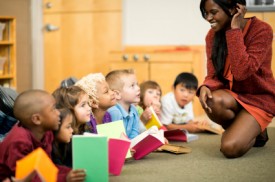 How can we build better readers? What should we be doing to ensure each student leaves the classroom able to read better than they did when they arrived? Teachers are plagued by these questions. Even when teachers are highly prepared and expertly understand the strategies for reading improvement, learners may disengage. With limited instructional time and the added pressures of today’s classrooms, teachers need effective student engagement strategies along with appropriate instructional strategies for reading improvement.
How can we build better readers? What should we be doing to ensure each student leaves the classroom able to read better than they did when they arrived? Teachers are plagued by these questions. Even when teachers are highly prepared and expertly understand the strategies for reading improvement, learners may disengage. With limited instructional time and the added pressures of today’s classrooms, teachers need effective student engagement strategies along with appropriate instructional strategies for reading improvement.
Guided oral reading, for example, is a highly effective instructional strategy for improving reading. But engaging all students with sufficient guided oral reading opportunities is a daunting and difficult thing to do. Students who do not read well are often clever enough to find ways to avoid reading in front of their peers. I know from personal experience that students paired together may sometimes “cheat,” letting the stronger reader do all of the reading while the struggling reader listens. Too often, the students who need it most simply do not get the daily reading practicethey need to grow their skills.
Reading comprehension—the entire aim of reading—requires active engagement. Too often students read a text purely with the intent of moving through it and completing the assignment. The purpose of reading for learning and discovery is lost to them. Students need to be drawn into the text. They need to use their background knowledge, to make predictions, to concentrate on details and hold information in their minds. The reading practice needed to realize improvement cannot be a passive activity.
Picture for a moment an engaged classroom working on a reading lesson. We would see every student participating, each one of them focused on learning. We’d see body language reflecting their mental participation and physical responses as they learn. We would also hear them asking questions and getting excited about what they were reading. A zealous vibe would be palpable. When we feel that excitement in a classroom we know that our instructional strategies are working to help students learn.
So what can we do, as teachers, to help our students engage?
- Make the challenge manageable.It’s important for us to assess student ability and find the right balance of challenge and success. Appropriate challenge is motivational.
- Make the learning meaningful.Students engage when their learning is made relevant to their lives and they are able to feel connected to what they are doing.
- Provide feedback in the moment.When students get the feedback they need as they need it, they can compete against themselves and see growth.
Self-esteem is built through engaged, dedicated effort that yields results. Our focus needs to be on ensuring participation, motivation, and excitement around reading for every student.

